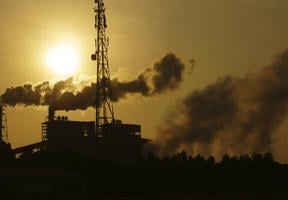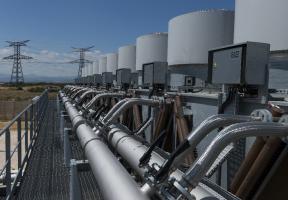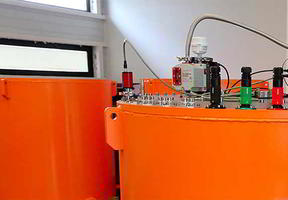Factsheet: Energy in the United Kingdom
10 min read
Find out all about the British : consumption, generation and the outlook for the future. Explanatory tables to understand the main principles of energy policy in the United Kingdom and its actions to combat . This factsheet can be used across the board to prepare lessons on the United Kingdom, in subjects such as history, geography, economic and social science, physics and chemistry, engineering science and modern languages.
A Bit of History 🧑🏫
The Industrial Revolution began in the United Kingdom in the middle of the 18th century, thanks to the modernity of its economic structures and abundant resources, in the North of England and Wales.
In the first half of the 20th century, drawing on its colonial empire, the country embarked on a second revolution, that of oil.
In 1983, after violent clashes with miners, Margaret Thatcher’s government began to phase out coal production. She diversified the British energy mix by developing oil and gas in the North Sea, beginning a nuclear program and liberalization of the market.
In 2008, a law on climate change started an ambitious policy for the development of renewable energies, driven by wind and offshore wind.
The Basics 💡
The Energy Mix
The energy mix describes the distribution of the different
sources used for domestic energy consumption in a given country.
This table shows the consumption of primary energies in the United Kingdom in 2023, expressed as a percentage.
Sources | 2023 |
Coal | 2.6% |
Oil | 38.7% |
Natural gas | 33% |
Nuclear | 5.3% |
Hydro | 0.7% |
Other renewables | 20% |
Source: Statistical Review of World Energy 2024
In 2023, the United Kingdom produced over a third of its gas supply thanks to the North Sea.
Coal has been virtually eradicated from the British energy mix.
Who Consumes the Energy?
At the end of the chain, this table shows the share of final energy consumed by the different sectors in 2023.
Sectors | 2023 |
Transport | 30% |
Residential | 32% |
Industry | 18% |
Service | 13% |
Agriculture | 1% |
The Electricity Mix
The power generation (or electricity) mix refers to the combination of the various types of energy sources used to generate electricity in a given geographic region.
This shows the share, expressed as a percentage, of the different sources of electricity in 2023 in the United Kingdom.
Sources | 2023 |
Coal | 1.2% |
Oil | 0.8% |
Natural gas | 34.3% |
Nuclear | 14.3% |
Hydro | 1.8% |
Wind | 28.7% |
Solar | 4.8% |
Other renewables | 14% |
Source: Statistical Review of World Energy 2024
produced 28.7% of the power consumed in the United Kingdom, a higher share than in Germany.
The “other renewables” includebiomass (wood, incinerated waste, etc.), energy from the tide, the waves, currents or from the Earth ( energy).
Greenhouse Gases
Year | Emissions in millions of tons of CO2 equivalent |
2000 | 550 |
2010 | 497 |
2020 | 406 |
2021 | 426 |
2022 | 412 |
2023 | 384 |
Source: Statistical Review of World Energy 2024
Since 2000, the trend has significantly decreased due to the efforts made to fight against climate change.
Certain events cause high annual variations, such as the COVID-19 pandemic, that slowed down the economy in 2020.
Future Outlook
- The United Kingdom is aiming for carbon neutrality in 2050, with an ambitious step to reduce emissions by 78% by 2035.
- To achieve this, the country wants to accelerate the development of nuclear energy, which does not generate CO2. Wind power will follow and the largest wind farm should be brought online in 2027, at 160 km off the Yorkshire coast. The aim is to multiply the solar capacity fivefold by 2035, and to increase the production of green .
- In summer 2023 however, the government made controversial decisions to help boost its : Restarting oil and gas production in the North Sea, projects for the construction of gas power stations, and bringing the gasoline and car ban to 2035 (as in the EU).
What is the main renewable energy developed in the United Kingdom?
Wind energy, particularly offshore.
Why is the United Kingdom reviving gas production in the North Sea?
To increase its energy independence and rely less on outside sources in a period of geopolitical uncertainty, in particular since the war in Ukraine.
In geography (grades 7-9), this factsheet provides recent data on the energy mix and emissions in the United Kingdom, related to the topic of “Preventing climate change risks”.
The challenges of the British (renewables development, coal being phased out, electrification).
In sciences (grades 7-9), the different sources of energy (fossil, nuclear, renewable) and their environmental impacts are covered, in relation to the theme of “Energy resources”.
In geography (grade 10), the case of the United Kingdom is used to study the challenges of the energy transition in a developing country, in relation to the question of “Why and how to develop the region?".
In engineering sciences (grade 11), renewable energies (wind, solar) and nuclear technologies developed in the United Kingdom can be analyzed as part of the curriculum.
- Ask students to create a diagram to summarize the energy mix in Britain using data from the factsheet, and ask them to think about the advantages and disadvantages of each energy source.
- Organize a debate in class on energy objectives in the United Kingdom and the means for achieving them, based on the challenges described on the factsheet.
- Suggest an exercise to compare energy consumption in the United Kingdom and France using the same factsheet “Energy in France” on the Planète Energies website.
Analyze governmental policies and strategies
- Study the “Net Zero Strategy” in detail, published in 2021, which sets out the roadmap to achieve carbon neutrality by 2050.
- Analyze the specific measures planned to decarbonize the different sectors (electricity, transport, industry, construction, agriculture, etc.).
Monitor key technological developments:
- The deployment of renewable energies, in particular offshore wind that is a priority.
- The development of with new reactors in the pipeline.
- Progress in CO2 capture, storage and use (CCUS), and low-carbon hydrogen.
Investigate the socio-economic challenges:
- The massive investments required and the planned financial mechanisms.
- Impacts on employment and the industrial reconversions to be planned for.
- Challenges in terms of social acceptability of the new energy infrastructures.
- The role of individual behaviors and changes in lifestyle.




















